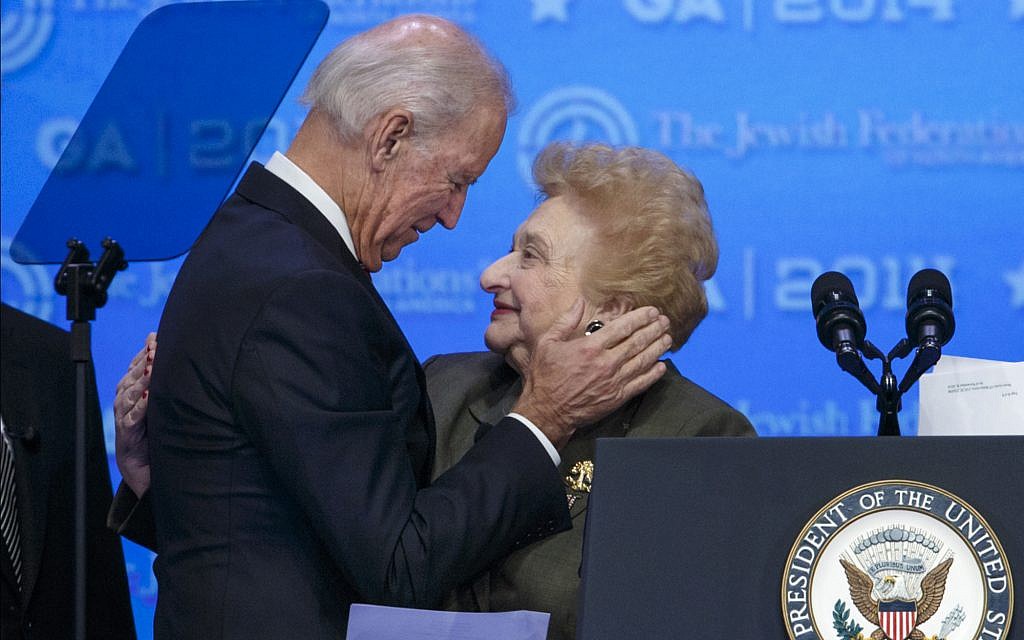|
 The
following 28 Jews are in Creepy Joe’s Cabinet
and most important Administrative positions:
1) Doug Emhoff, Jewish Husband of VP Kamala Harris
2) Janet
Yellin, Jewish Secretary Treasury
3) Anthony Blinken, Jewish Secretary of State
4) Robert Klain, Jewish Chief of
Staff
5) David Cohen, Jewish Deputy Director CIA
6) Merrick Garland, Jewish Attorney General
7) Alejandro Mayorkas,
Jewish Secretary Homeland Security
8) Avril Haines, Jewish Director National Intelligence
9) Wendy Sherman, Jewish
Deputy Secretary of State
10) Victoria Nuland, Jewish Secretary State Political Affairs
11) Eric Lander, Jewish
Office of Science Technology
12) Jeffry Zeints, Jewish Covid Czar
13) Rachel Levine, Jewish Assistant Health Secretary
14) and 15) Cass Sunstein, Jewish Senior Counselor at the Department of Homeland Security, and his wife, Samantha Power,
Head of USAID
16) Dana Stroul, Jewish Pentagon Senior Policy Official on the Middle East
17) Rochelle P. Walensky,
Jewish CDC Director
18) Anne Neuberger, Jewish Director of Cybersecurity at NSA
19) Chanan Weissman, Jewish Director
of Technology at National Security Council
20) Avril Haines, Jewish Director of National Intelligence
21) Polly
Trottenberg, Jewish Deputy Secretary of Transportation
22) Jessica Rosenworce,l Jewish Acting Chairwoman FCC
23)
Jennifer Klein, Jewish Co-Chair of the Gender Policy Council
24) Jared Bernstein, Jewish Member of Council of Economic
Advisers
25) Jeff Zients, Jewish COVID Czar
26) David Kessler, Jewish Chief Science Officer of COVID Response
27) Stephanie Pollack, Jewish Deputy Administrator Federal Highway Administration
28) Gary Gensler, Jewish Chairman
of the Securities and Exchange Commission
You may ask yourself, what is the likelihood of this happening? The chance of these 28 Jews to be in the most important positions in the United States government, well, that’s impossible. But
yet it has happened through a coup d’etat. With a blatantly stolen election, these
28 conniving Jews, have now seized positions of incredible power within the
United States government. World War Three is here folks. All without a shot yet to be fired, that is except for the billions of mRNA shots being pushed around the world to the immensely inculcated and dumbed down masses. Now is the time to remember what the Jews did to the Christians in Russia when they gained power. They murdered 66,000,000 of them. Then you may ask yourself, how many of these 28 Jews that are in Creepy Joe’s Cabinet and most important Administrative positions,
are also dual citizens with Israel? Since
they don’t want you to know this answer to this important question, I would say most, or possibly all of them. In the words of the most traitorous
spy in the history of the United States:
“We’re Jews… We Will Always Have Dual Loyalty” Jonathan Pollard 
Click on this text to watch watch Biden sell-out White America
5
Jewish things to know about Joe Biden Former
VP who will announce his 2020 candidacy on Thursday has a long, deep
Jewish record, from his oft-told anecdotes about Golda Meir to his Jewish in-laws
WASHINGTON (JTA) — Joe Biden, a born and raised Roman Catholic
who likes to cross himself when making a point, knows what faith he would be if he were ever overcome with doubt about his
own. “If I’m going to switch, I know where
I’m going,” the former vice president said in 2016 at an Ohio political event when someone in the audience called
him a “mensch.” Biden went on to describe the pile of yarmulkes he had accumulated from attending Jewish events.
Goodness knows, he’s been collecting them for a
while, and his Jewish ties run deep: One of his first overseas visits in his long career as a senator was to Israel, on
the eve of the 1973 Yom Kippur War. Which is all the more remarkable considering that Biden represents a state, Delaware, with a Jewish population estimated
at 15,000. 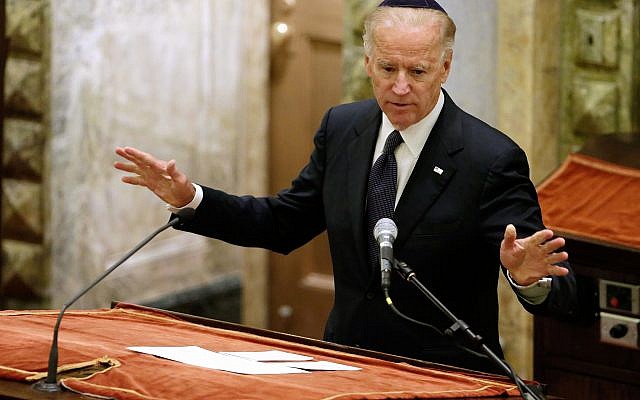 U.S. Vice President Joe Biden speaks during the funeral for U.S. Sen
Frank Lautenberg, in New York’s Park Avenue Synagogue, Wednesday, June 5, 2013. (AP Photo/Richard Drew, Pool) How deep is Biden’s
Jewish record? So deep that it was hard to pick just five Jewish things to know about him. Here are his greatest hits, sure to be repeated once Biden, 76, announces
on Thursday that he is entering the stakes for the Democratic presidential nomination. He learned pro-Israel from his dad.
Biden, born in 1942, likes to recall a childhood memory of his salesman father, Joseph
Sr., and the international debate in 1948 over whether to endorse the existence of the new State of Israel. Typically he
leavens the tale with details suggesting a raucous Irish-American upbringing in which folks liked talking over one another
more than they did eating. “My
education started, as some of you know, at my father’s dinner table,” Biden said at an American Israel Public
Affairs Committee annual conference in 2013. (“As some of you know” was an understatement: Many folks on the
pro-Israel circuit have memorized Biden’s Jewish anecdotes, but that doesn’t diminish the applause.) “We gathered at my dinner table to
have conversation, and incidentally eat, as we were growing up. It was at that table I first heard the phrase that is overused
sometimes today, but in a sense not used meaningfully enough — first I heard the phrase ‘Never again.’ 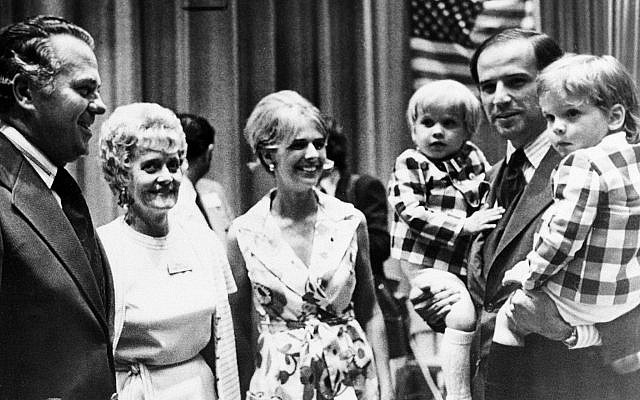 Sen. Joe Biden (D-Del.) carries both of his sons, Joseph R. III, left,
and Robert H., during an appearance at the Democratic state convention last summer, 1972. At center is his wife Neilia Biden,
who was killed in an auto crash, Dec. 20, 1972. With them are Governor-elect Sherman W. Tribbitt and his wife, Jeanne. (AP
Photo) “It
was at that table that I learned that the only way to ensure that it could never happen again was the establishment and the
existence of a secure, Jewish state of Israel. I remember my father, a Christian, being baffled at the debate taking place
at the end of World War II talking about it” — baffled, that is, that anyone would consider voting no. That Golda story All rumors you’ve heard about a “Golda” drinking game
among reporters who cover Biden Jewish events is utterly baseless. So, that cleared up, here’s the deal: Joe Hearts Golda Meir. A lot. The story he tells
about meeting with her in 1973, when he was a 30-year-old senator, is a staple of his Jewish speechmaking. It was on the eve of the Yom Kippur War. Biden toured Israel and the territories
it held and witnessed the chain-smoking, American-born Israeli prime minister reviewing maps. He could not but notice heightened
military tensions. 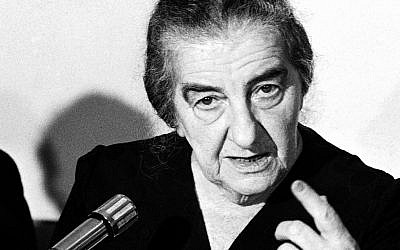 Israeli Premier Golda Meir during a press conference at the Israeli
Embassy in Rome January 15, 1973. (AP Photo/Giuseppe Anastasi) Meir, meeting Biden at her office, asked him to pose for a photo. “She said, ‘Senator, you look
so worried,’” he recalled, speaking at an Israeli Embassy Independence Day celebration in 2015. “I said,
‘Well, my God, Madame Prime Minister,’ and I turned to look at her. I said, ‘The picture you paint.’
She said, ‘Oh, don’t worry. We have’ — I thought she only said this to me. She said, ‘We have
a secret weapon in our conflict with the Arabs. You see, we have no place else to go.’” Biden has a Jewish family. He jokes about it. But it’s complicated. Biden has three children who grew to adulthood. (His first wife, Neilia,
and a baby daughter, Naomi, died in a car crash right after his 1972 election to the Senate.) Two of them married Jews: Beau Biden, whose mother was Neilia, married
Hallie Olivere. Ashley Biden, his daughter with his second wife, Jill, married Howard Krein. “By the way, I’m the only Irish Catholic you know who had his
dream met because his daughter married a Jewish surgeon,” he said at that 2016 Ohio political event. 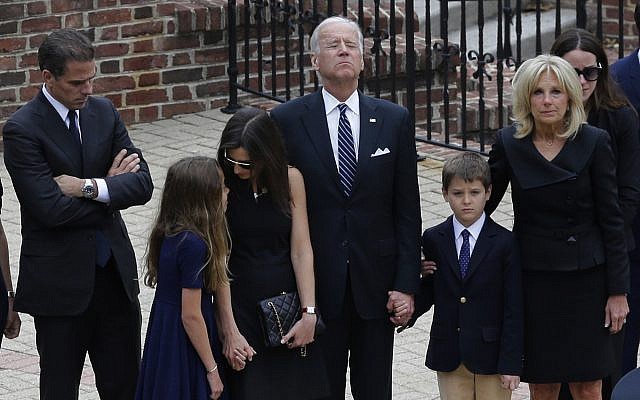 Vice President Joe Biden, center, pauses alongside his family as they
to enter a visitation for his son, former Delaware Attorney General Beau Biden, Thursday, June 4, 2015, at Legislative Hall
in Dover, Del. Standing with Biden are his son Hunter, from left, granddaughter Natalie, daughter-in-law Hallie, grandson
Hunter and wife Jill. Beau Biden died of brain cancer Saturday at age 46. (AP Photo/Patrick Semansky, Pool, File) This is where it gets
complicated: Beau died of cancer in 2015. Hallie subsequently had a romantic relationship with his younger brother (also
a son of Neilia), Hunter, who was splitting up with his wife, Kathleen. (It’s not clear if the relationship with Hallie
precipitated the divorce.) The Hallie-Hunter relationship reportedly is over. Added ick factor? According to The Daily Mail, the elder Biden confessed
that growing up in Wilmington, Delaware, he had a crush on Hallie’s mother, Joan. “I was the Catholic kid. She was the Jewish girl. I still tried. I
didn’t get anywhere,” Biden said at a Delaware Jewish event in 2015. Biden-Begin did not go as well as Biden-Golda. In 1982, Menachem Begin met with senators during a tour of Israel. The
prime minister fumbled when asked about Israel’s recent Lebanon invasion, but rallied when Biden confronted him about
West Bank settlement expansion and suggested that new settlements would undercut US support for assistance for Israel. Biden
reportedly banged the table as the exchange grew heated. Begin’s reply has become lore among his followers. “This desk is designed for writing, not for fists,” he said,
according to an account written by a confidante just after Begin’s 1992 death. “Don’t threaten us with
slashing aid. Do you think that because the US lends us money it is entitled to impose on us what we must do? We are grateful
for the assistance we have received, but we are not to be threatened. I am a proud Jew. Three thousand years of culture are
behind me, and you will not frighten me with threats. ” 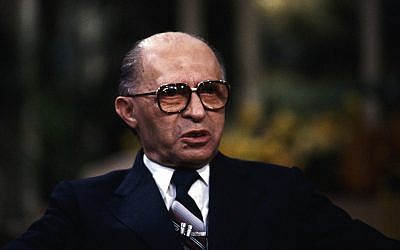 In this November 16, 1980 photo, Israeli Prime Minister Menachem Begin
as he appeared on the ABC program ‘Good Morning America.’ (AP Photo)
Biden was chastened enough that two years later he appeared
at the annual conference of Herut Zionists of America (Herut was Begin’s original party) and blamed the impasse in
Middle East peace on Saudi Arabia, Jordan and the Palestine Liberation Organization. Biden’s pledge then: “My
first order of business in the new Senate will be to educate my colleagues on the financial sacrifices Israel has made as
a result of Camp David.” In
2010, a matured Biden figured out passive aggressiveness worked better than fist banging when it came to settlements. On
a friendly visit to Israel, Biden was surprised to learn that Prime Minister Benjamin Netanyahu’s government had announced
new building in eastern Jerusalem. Biden’s payback? He made Netanyahu wait 90 minutes for a dinner meeting. He knows his audience. Within two months in 2013, Vice President Biden spoke to AIPAC and then
its bete noir, J Street, the liberal Jewish Middle East policy group. The thrust of his AIPAC speech at the beginning of
March? Israeli leaders, including Netanyahu, want peace, and the Arabs need to step up. “Israel’s own leaders currently understand the imperative of
peace,” he said. “Prime Minister Netanyahu, Defense Minister Barak, President Peres — they’ve all
called for a two-state solution and an absolute secure, democratic and Jewish state of Israel to live side by side with
an independent Palestinian state. But it takes two to tango, and the rest of the Arab world has to get in the game.” 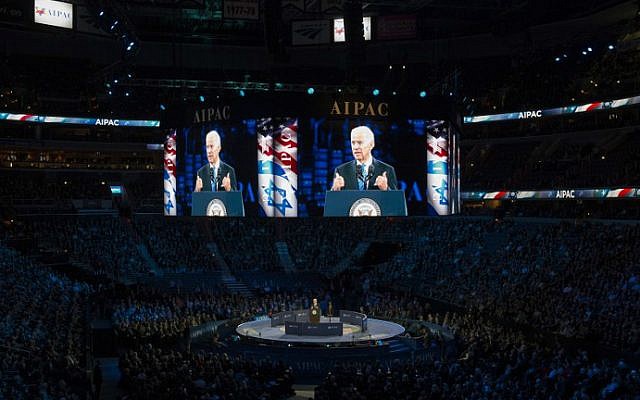 US Vice President Joe Biden speaks at the AIPAC 2016 Policy Conference
on March 20, 2016 in Washington, DC. (Molly Riley/AFP) The thrust of his J Street speech, mid-April? Netanyahu was taking the country
in the “wrong direction.” “I firmly believe that the actions that Israel’s government has taken over the past several years —
the steady and systematic expansion of settlements, the legalization of outposts, land seizures — they’re moving
us and, more importantly, they’re moving Israel in the wrong direction,” he said.
___________________________________________________________________________________________________

This is how
the ‘Court Jews’ have been strategically placed into power families over millennia. Reflections on Jewish Intermarriage into Native Elites 
“I want to thank my Jewish daughter. I have a Jewish daughter.
This wasn’t in the plan but I’m very glad it happened.” – Donald Trump, February
2015. (ILLUSTRATION: Donald Trump’s Jewish son-in-law, Jared
Kushner) by Andrew Joyce
AS DISCUSSION CONTINUES among White advocates over the Trump candidacy, I haven’t
failed to notice that perhaps the most persistent criticism of Trump from our ranks has been his strong links to
Jews, in particular his familial ties to Jewish blood. There’s certainly some substance to this. Trump’s
daughter, Ivanka, has adopted the Jewish religion as her own and has been married to Jewish real estate speculator
Jared Kushner since 2009. Both of Donald Trump’s grandchildren are Jewish. Looking into the situation in
more detail, I was intrigued to discover that Ivanka’s previous two significant relationships were also
with Jews, Greg Hirsch and James Gubelmann. Of further note is Ivanka’s very close friendship with Chelsea
Clinton, another progeny of the American power elite, who married the Jewish financier Marc Mezvinsky in 2010. The Trump
and Clinton situations are excellent examples of the centuries-old practice of strategic Jewish intermarriage
with native elites, and this phenomenon deserves some focused attention.
Jewish intermarriage into non-Jewish power elites is a significant but under-researched
aspect of Jewish strategies to maintain and expand influence. At first sight, of course, it appears paradoxical.
A major part of the Jewish group evolutionary strategy is concerned with segregation of the gene pool and preventing
high levels of genetic admixture from surrounding groups. Judaism has historically been replete with social and
cultural controls designed to minimize contact with non-Jews, and therefore greatly inhibit admixture. Additionally,
converts are dissuaded and scorned in Judaism in a manner quite without parallel in any other religious culture.
However, as Kevin MacDonald has noted in A People That Shall Dwell Alone (2002, hereafter PTSDA),
conversion and admixture were permissible, if not eagerly sought, when such an admixture was very small and offered
significant net benefits to the group. Similarly, at the opposite end of the Jewish strategic ghetto, controls
were also far from airtight — the most sincere Jewish apostates to Christianity tended to be overwhelmingly
poor and obscure, and were little mourned by the group at large. The eugenic benefits of pursuing such a strategy are
obvious. Even in ancient times there is evidence that “some
gentile-derived genes were being selected for their effects on resource-obtaining abilities within the Jewish community
(PTSDA, 41).” By targeting the rich and powerful for intermarriage, Jews could obtain significant
and immediate material resources, an improvement in social status, and also useful genetic material. Though very
few in number, ancient converts, and their more celebrated modern counterparts, have been disproportionately intelligent
and successful. MacDonald writes that It is possible that even this relatively small genetic admixture from surrounding
populations could be adaptive for a strategizing group because the group would benefit from new genetic combinations,
e.g. intelligence, greater phenotypic similarity etc…Evidence in favor of this hypothesis would be that
Jewish proselytism, while highly limited and restricted, has been more successful among wealthy, intelligent,
and talented individuals and that this pattern was actively encouraged by the Jewish community (PTSDA,
Chapter 2, 41).[1] Earlier this year Princeton University
Press published Todd Endelman’s Leaving the Fold: Conversion and Radical Assimilation in Modern Jewish
History. Endelman’s work purports to examine phenomena like intermarriage and conversion but, typically
for mainstream Jewish scholarship, it neglects to engage in any real sense with aspects of these phenomena that reflect
less favorably on Jewish culture, particularly the nature of elite-level intermarriage. However, there are a few
useful snippets of information that offer substantiation for MacDonald’s observations. Those Jews who drifted
into the non-Jewish gene pool were indeed, according to Endelman, “swindlers, drunkards, whores, schlemiels,
schlemazels, nudniks, and no-goodniks” whose “social, cultural, and even moral level was low.”[2]
By contrast, those non-Jews welcomed into the Jewish fold were from the very highest social levels,
and the efforts taken to entice young princes, landowners, or heirs of industry to take Jewish wives were remarkable
for their long-term, premeditated nature. Endelman remarks on census data from Berlin, covering the period 1770–1826,
which indicates that elite Berlin Jews were utilizing baptism as “a long-term strategy to make their daughters
eligible for eventual intermarriage.”[3] 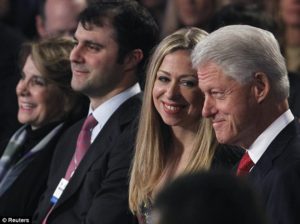 Chelsea Clinton and her Jewish husband Marc Mezvinsky with Bill Clinton Chelsea Clinton and her Jewish husband Marc Mezvinsky with Bill Clinton Of course, the most significant barrier to Jewish attempts to intermarry with the non-Jewish elite were the religious
aspects of marriage, and the requirement that Jews convert to Christianity before being permitted to take a Christian
spouse. This barrier only began to weaken in the late eighteenth and early nineteenth centuries, beginning in
the German-speaking lands where some of the aforementioned leading Jewish families began baptizing their daughters
in long-term strategies for intermarriage with the Prussian elite, the Junkers. By the late 1700s many of the
Junkers had fallen on hard times financially, due in large part to Jewish predation. The same period witnessed
a boom in the wealth of Jewish bankers. Deborah Hertz writes in Jewish High Society in Old Regime Berlin that
“discrete private loans to those who could afford the high interest rates was one way that the Jewish bankers
increased the wealth they acquired in the Seven Year’s War.”[4] Indebted nobles began frequenting
the homes of their Jewish creditors, either to make payments or plead for extensions. It was in these circumstances
that the first fraternization began between the Prussian nobility and the daughters of the Jewish elite. There
is even some suggestion that nobles were heavily pressured, via their debts, to take Jewish wives for easier terms.
For example, Hannah Arendt argued that intermarriages between the Prussian nobility and Jewish women were simply
“a continuation of the creditor-debtor exchanges of the earlier years.”[5] Eventually this mode of contact
evolved into the “salon” culture, in which soirées were staged and hosted by Jewish financial
magnates with the specific purpose of encouraging the mixing of the Prussia nobility and selected Jewesses.[6] Civil marriage wasn’t introduced in Prussia until 1874. Until then there were
a considerable number of insincere conversions that facilitated intermarriage but failed to disguise the fact that
the Jewish wives of the Prussian nobility continued to carry on Jewish lives. Hertz describes the Jewish families
as “socially opportunistic” strategizers who were motivated by “status-hungry desires”
and “craved the higher positions possessed by Christians.”[7] The vast majority of Jewish women who
married into the Junker class derived many of the social benefits now attached to their status in non-Jewish society,
while retaining “strong ties to friends and relatives who remained Jewish.”[8] The flurry of Jewish
intermarriages into the Prussian elite only began to ebb away around 1813, when Prussian society witnessed a backlash
against the encroachment, and a number of “anti-Semitic” salons were established.[9]Many of the salon
women were treated with scathing disdain by those members of the elite who resented the Jewish incursion. For
example, Wilhelm von Humboldt, the Prussia philosopher and diplomat, once described salon star Rahel Levin as a
“monster.” And when Levin married Karl August Varnhagen von Ense, the cream of the Prussian elite,
von Humboldt asked a friend whether “there was anything a Jew could not achieve.’”[10] 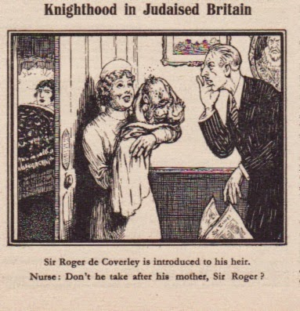
Although the salons of Prussia and Paris facilitated the extension and
deepening of Jewish influence, no nineteenth-century native elite was subjected to Jewish penetration as strongly
as the British aristocracy. In 1936 England’s Arnold Leese, a former military veterinarian and leader of
a small Fascist group, published a pamphlet titled Our Jewish Aristocracy: A Revelation. At the outset of the publication, Leese wrote that he wished to impress upon his fellow Britons that “their
race is being displaced and replaced, and without notice to any individual.” Compared with our contemporary
situation, Leese couldn’t even imagine what genuine displacement and replacement would actually look like.
However, what Leese did manage to produce was a valuable, though imperfect, piece of research that made a convincing
case for the argument that the British elite was being slowly displaced and replaced with Jewish
genes. My careful re-examination of his lengthy list of British nobles with Jewish ancestry indicates that Leese
made a handful of errors, but the majority of those listed were indeed related to Jews by blood or marriage. In his classic work, The Jews (1922), Hilaire Belloc wrote that Jewish
intermarriage into the British elite was more “subtle and penetrating” than even the Jewish acquisition
of key positions in the institutions of the State. Belloc stated that: Marriages began to take place, wholesale, between what had once been the aristocratic territorial families
of this country and the Jewish commercial fortunes. After two generations of this, with the opening of the twentieth
century those of the great territorial English families in which there was no Jewish blood were the exception.
In nearly all of them was the strain more or less marked, in some of them so strong that though the name was still
an English name and the traditions those of a purely English lineage of the long past, the physique and character
had become wholly Jewish and the members of the family were taken for Jews whenever they travelled in countries
where the gentry had not yet suffered or enjoyed this admixture (223).
The two main reasons for the more extensive Jewish penetration of the British aristocracy
were the earlier introduction of civil marriage, and the admission of Jews to the hereditary peerage on a par with
the native elite (beginning with Nathan Mayer Rothschild in 1884). Endelman writes that in Britain, “marriage
without a religious ceremony became legal in 1837, and in 1839 Hannah de Rothschild (1815–1864), daughter
of the founder of the English branch of the banking clan, married Henry FitzRoy, younger son of the second Lord
Southampton, at St. George’s, Hanover Square, without first becoming a Christian.”[11] Although romantic
historical renditions of the marriage portray it as a love affair between two people whose families objected to
the pairing, the ensuing scale and extent of Jewish intermarriage into the peerage following the union suggest
that the Rothschilds and the wider Anglo-Jewish Cousinhood were very keen on the development. In fact, within a century the scale of Jewish intermarriage with the British aristocracy
was such that it led L.G. Pine, editor of Burke’s Peerage from 1949–1959, to write
in 1956 that “the Jews have made themselves so closely connected with the British peerage that the two classes
are unlikely to suffer loss which is not mutual.” Pine’s
astute comment bears some reflection because it cuts to the heart of Jewish intermarriage with native elites.
Jews historically have tirelessly engaged in efforts to position themselves either in elite positions or in positions
that place them between the elite and the great mass of people. Jews have sought these positions of power and
influence in order to pursue their goals and interests — goals and interests which are very often at odds
with the interests of native populations. This conflict of interests is the root cause of what has been termed
“anti-Semitism,” and one of the main strategies Jews have employed against “anti-Semitism”
is that of crypsis. Cryptic strategies have involved insincere conversions to Christianity and the abandonment
of phenotypic characteristics that provoke hostility. The argument here is that Jewish intermarriage with native
elites should be seen, partly, as a more extreme example of Jewish crypsis. What better way for a foreign
elite to occupy powerful positions in a society than to do so in a manner which gives the impression that the foreign
elite is nothing more than the traditional, native elite? By inter-breeding so acutely with the native elites,
and blending their interests so tightly, the strategy also places further distance between the native elite and the people
it leads. As Pine suggests, the native elite can no longer act on behalf of the people and against foreign influence
because intermarriage has ensured that any Jewish loss would in fact be “mutual.” The Trump and Clinton intermarriages should be seen as part of this greater
strategy of expanding power and influence cryptically, and “normalizing” or blurring the image of Jews
at the top of our society. Also, in the same way that one injects small amounts of microbes in order to immunize
oneself against a disease, by taking in small amount of the “best” genes or personalities Jewry “immunizes”
itself against the threat of a reaction from the financially and politically powerful. To be clear, although it
is clearly helpful, the argument here is not that intermarriage is any longer essential to the
expansion of Jewish power and influence. It’s continuance in the present is in part merely a symptom of the
geriatric, decayed, and increasingly alien nature of our existing elites. Our sick society has an elite composed
of media types, corporate vultures, and opportunistic politicians. And when a society hands over the top positions
of power and influence to the financially rich but morally and ideologically bankrupt, it will not be cream that
rises to the top, but scum. Jews no longer have to
reach across a cultural Rubicon in order to penetrate an exalted native elite. They already occupy the same dubious
space as it. In Diversity in the Power Elite: How It Happened, Why It Matters (2006) G. William
Domhoff and Richard Zweigenhaft state that “Jews are overrepresented overall in the corporate elite. Jews are
also now overrepresented in both the Senate and the House.”[12] The need for the salons has long since dissipated.
The rotten elites, both foreign and domestic, can intermingle in their board rooms and political venues, their
fates and interests, as Pine stated, now entwined. Chelsea Clinton and Marc Mezvinsky, the son of an Iowa Congressman
and a Philadelphia Congresswoman, met at a 1993 Democratic political retreat in Hilton Head, South Carolina. Ivanka
Trump met Jared Kushner in a heavily-Jewish social milieu built around the upper echelon of corporate real estate.
The social circles are mutual. A couple of weeks ago, during
a conversation with a White advocate of many years’ service, I was asked my opinion on the monarchies of
Europe and their future. I replied that although I have a lingering respect for centuries of tradition, the time
has come for the decrepit old elites to be swept away. In the course of the ongoing invasion of foreign peoples
into Europe, the remaining aristocracies will not survive long anyway. The invaders will not respect the history,
tradition or authority of people who are no more than relics of past European glories. The inbred, quasi-Jewish
denizens of Europe’s crumbling manorial estates may lock the doors of their palatial residences, but if
push came to shove, they would be no more spared the ravages of a racial conflict than the humblest member of society.
Nor should we mourn the passing of these people and their toppling from power and influence. These older elites
have had centuries to prove that they deserved their positions through service to the folk and concern for the
collective material well-being. Time and again they failed. Their corporate and political successors are failing
even more rapidly, and much more profoundly. If
it can be said that many White advocates are elitists in the sense that they reject the proposition that “all
men are equal,” it must be made clear that this in no way suggests support or endorsement for the existing
elite, or the qualifications by which this group claims elite status. Quite the opposite. We are thus both elitist
and “anti-elite.” In the same way, we acknowledge the influence of genes and heredity on one’s
personality, behavior, and abilities but reject the idea that heredity alone is a qualification for individual
or familial power. One does not find hereditary elites in nature. A lion may rule a pride but none of his cubs,
talented though they may be, are necessarily destined to take his place. In the long history of monarchy in Europe,
Fate placed a crown upon a genius only once in centuries. The remainder of these ages witnessed Europe laboring under
despots, the mediocre, the inept, the feeble, the cowardly and the venal.
One of the great lies fed to the masses is that we now live in an era of meritocracy, with access to elite status open to anyone who is “talented”
enough. But the lie doesn’t bear up under closer scrutiny. Even if one adopts the position that successfully
competing to get into a “meritocratic” institution like an elite university is an avenue towards eventual,
wider, elite status, one is confronted with phenomena like Jewish overrepresentation at elite universities. The fact remains that we live in what a January 2015 article in The Economist described as a flawed “hereditary meritocracy.” The hereditary meritocrats
who compose our modern elites benefit from social and ethnic networking in much the same way as the hereditary
aristocrats did in earlier periods. There are gatekeepers controlling access to elite universities, elite media
positions, and elite social functions. As has been stated, Jews are massively overrepresented across all indicators
of elite power and influence. Meritocracy, like modern democracy, is an illusion.
This discussion is aimed primarily at moving us away from references to “our”
elite, as opposed to the Jewish elite. If anything resembling the old WASP elite still exists in America, it is
either moribund, corrupted, or beyond saving. The salvation of our people will not come from throwing our support
behind an imagined non-Jewish group already possessing some wealth and power. As discussed above, interests and
bloodlines have been intertwined enough for any such group to view a decline in Jewish power as a decline in its
own. “Our” elite isn’t really “ours” at all. There is simply one, heavily-Jewish,
elite, and we are in ideological, material, and spiritual opposition to it. How excited, then, should we really
be about Donald Trump? For all his bluster, Trump is a creation and product of the bourgeois revolution and its
materialistic liberal ideologies. We are teased and tantalized by the fantasy that Trump is a potential “man of
the people.” But I cannot escape the impression that he is a utilitarian and primarily economic character,
who seeks a social contract based on personal convenience and material interest. In his business and political
history I see only the “distilled Jewish spirit.” In his family tree I see distilled Jewish blood.
Time will tell how useful his “drawing attention to the immigration issue” will be. Time will also
tell whether, if he is successful in reaching the White House, he would do anything to reverse the decline of White
America. I’d love to be proven wrong. NOTES [1] A
recent paper notes that this process is quite common in nature and may well have occurred in humans. The technical
term for the spread of favorable genes from one population to another is “adaptive introgression.”
It has been proposed that human populations settling in Eurasia acquired beneficial genes “‘for free’
at a frequency of a few percent” from Neanderthals and other groups which then spread rapidly. The same
thing may have happened with Jewish populations in Europe, thus accounting for the superior IQ of Ashkenazi groups compared
to other Jewish groups, especially Middle Eastern Jews. Adaptation through the acquisition of new mutations is generally a slow process: it is rare for favourable alleles
to appear, and these are often lost by chance when they first occur in a single individual or in very few individuals.
By contrast, if favourable alleles have emerged in one group, they can spread to other groups relatively rapidly
by gene flow. This process, called ‘adaptive introgression’, is well documented in bacteria and plants,
and described in some cases in animals, but it has not previously been considered an important factor in human
adaptation. However, because Neanderthals and Denisovans lived in Europe and Asia for hundreds of thousands of
years, they presumably carried alleles that were favourable given the conditions where they lived. Through gene
flow, modern humans spreading across Eurasia from Africa could then acquire these alleles ‘for free’
at a frequency of a few percent, thus ensuring that they were not lost and could be acted upon by positive selection.
(Svante Pääbo, “The diverse origins of the human gene pool,” Nature Reviews—Genetics 16
(June, 2015), 313–314.
http://www.eva.mpg.de/fileadmin/content_files/staff/paabo/pdf/Paabo_Diverse_NatRevGen_2015.pdf [2] T. Endelman, Leaving the Fold: Conversion and Radical Assimilation
in Modern Jewish History (Princeton University Press, 2015), 77. [3] Ibid, 79. [4] D. Hertz, Jewish High Society
in Old Regime Berlin (Syracuse University Press, 2005), 214. [5] Ibid, 215. [6] Ibid, 207.
[7] Ibid, 210. [8] Ibid.
[9] Ibid, 258. [10] Ibid.
[11] Endelman, Leaving the Fold, 79. [12] G. W. Domhoff & R. Zweigenhaft, Diversity in the Power Elite: How It Happened, Why It
Matters (Rowman and Littlefield, 2006), 38. * * * Source: Occidental Observer ___
https://nationalvanguard.org/2015/10/reflections-on-jewish-intermarriage-into-native-elites/
|








